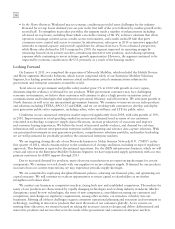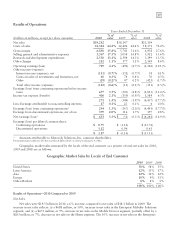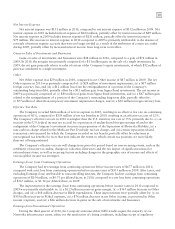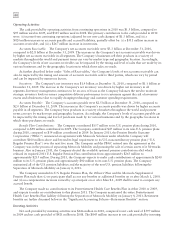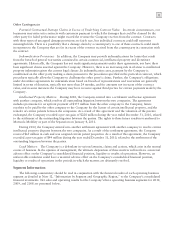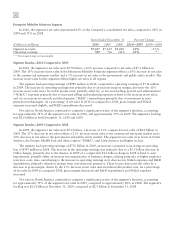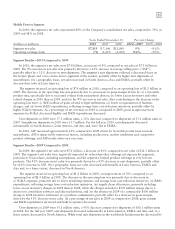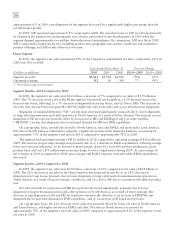Motorola 2010 Annual Report Download - page 53
Download and view the complete annual report
Please find page 53 of the 2010 Motorola annual report below. You can navigate through the pages in the report by either clicking on the pages listed below, or by using the keyword search tool below to find specific information within the annual report.
45
activities from 2009 to 2010 was primarily due to a $1.4 billion increase in cash received from net sales of Sigma
Fund investments, partially offset by: (i) a $207 million decrease in proceeds from sales of short-term investments,
(ii) a $132 million increase in acquisitions and investments, and (iii) a $131 million increase in capital expenditures.
Sigma Fund: The Company and its wholly-owned subsidiaries invest most of their U.S. dollar-denominated
cash in a fund (the “Sigma Fund”) that allows the Company to efficiently manage its cash around the world. The
Company had net proceeds from sales of $453 million of Sigma Fund investments in 2010, compared to
$922 million in net purchases of Sigma Fund investments in 2009 and $853 million of net proceeds received from
sales of Sigma Fund investments in 2008. The aggregate fair value of Sigma Fund investments was $4.7 billion at
December 31, 2010 (including $1.9 billion held by the Company or its subsidiaries outside the U.S.), compared to
$5.2 billion at December 31, 2009 (including $2.3 billion held by the Company or its subsidiaries outside the U.S.).
The Sigma Fund portfolio is managed by four independent investment management firms. The investment
guidelines of the Sigma Fund require that purchased investments must be in high-quality, investment grade (rated at
least A/A-1 by Standard & Poor’s or A2/P-1 by Moody’s Investors Service), U.S. dollar-denominated debt
obligations, including certificates of deposit, commercial paper, government bonds, corporate bonds and asset- and
mortgage-backed securities. Under the Sigma Fund’s investment policies, except for debt obligations of the U.S.
government, agencies and government-sponsored enterprises, no more than 5% of the Sigma Fund portfolio is to
consist of debt obligations of any one issuer. The Sigma Fund’s investment policies further require that floating rate
investments must have a maturity at purchase date that does not exceed thirty-six months with an interest rate that
is reset at least annually. The average interest rate reset of the investments held by the funds must be 120 days or
less. The actual average interest rate reset of the portfolio (excluding cash and defaulted securities) was 18 days at
December 31, 2010, compared to 15 days at December 31, 2009.
Investments in the Sigma Fund are carried at fair value. The Company primarily relies on valuation pricing
models and broker quotes to determine the fair value of investments in the Sigma Fund. The valuation models are
developed and maintained by third-party pricing services, and use a number of standard inputs, including
benchmark yields, reported trades, broker/dealer quotes where the counterparty is standing ready and able to
transact, issuer spreads, benchmark securities, bids, offers and other reference data. For each asset class, quantifiable
inputs related to perceived market movements and sector news may be considered in addition to the standard
inputs.
At December 31, 2010, $4.7 billion of the Sigma Fund investments were classified as current in the Company’s
consolidated balance sheets, compared to $5.1 billion at December 31, 2009. The weighted average maturity of the
Sigma Fund investments classified as current was 1 month (excluding cash of $2.4 billion and defaulted securities) at
December 31, 2010, compared to 1 month (excluding cash of $202 million and defaulted securities) at
December 31, 2009. A majority of the Sigma Fund’s cash balance at December 31, 2010 was reserved for the
Separation of Motorola Mobility. At December 31, 2010, approximately 99% of the Sigma Fund investments were
invested in cash and U.S. government, agency and government-sponsored enterprise obligations. This reflects a
strategic decision by the Company to prioritize capital preservation rather than investment income.
In 2010, the Company recorded a gain from the Sigma Fund investments of $11 million in Other income
(expense) in the consolidated statement of operations, compared to a gain from the Sigma Fund investments of
$80 million in 2009.
During the fourth quarter of 2008, the Company changed its accounting for changes in the fair value of
investments in the Sigma Fund. Prior to the fourth quarter of 2008, the Company distinguished between declines it
considered temporary and declines it considered other-than-temporary. When it became probable that the Company
would not collect all amounts it was owed on a security according to its contractual terms, the Company considered
the security to be impaired and recorded the other-than-temporary decline in fair value in earnings. In 2008, the
Company recorded $186 million of other-than-temporary impairments of Sigma Fund investments in the
consolidated statement of operations.
Beginning in the fourth quarter of 2008, the Company began recording all changes in the fair value of
investments in the Sigma Fund in the consolidated statements of operations. Accordingly, the Company recorded the
cumulative loss of $101 million on investments in the Sigma Fund investments in its consolidated statement of
operations during the fourth quarter of 2008. The Company determined amounts that arose in periods prior to the
fourth quarter of 2008 were not material to the consolidated results of operations in those periods.



